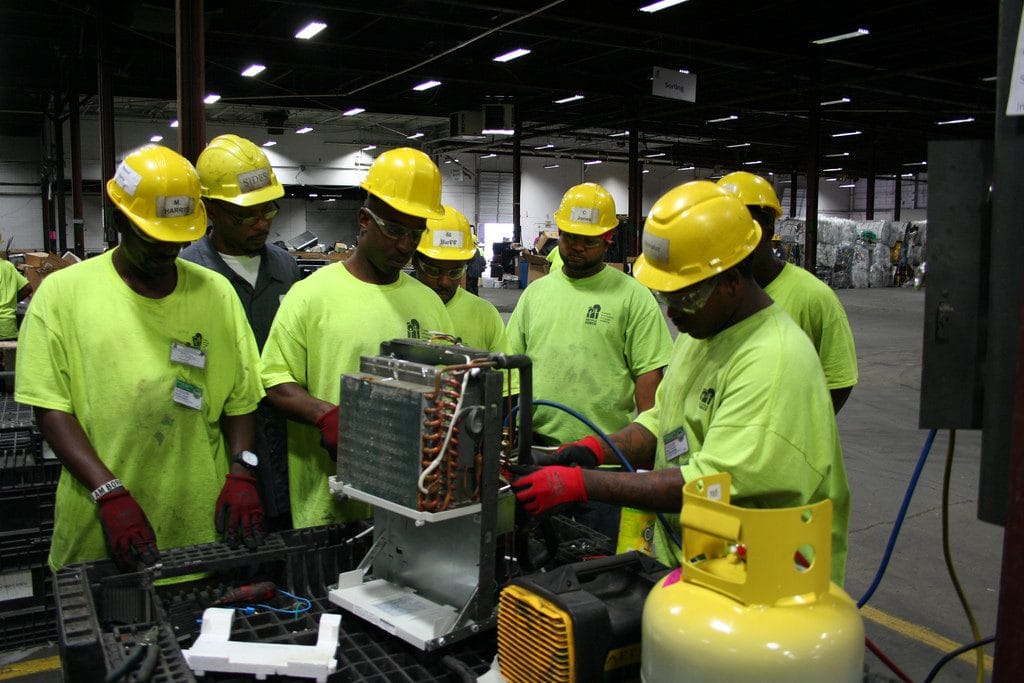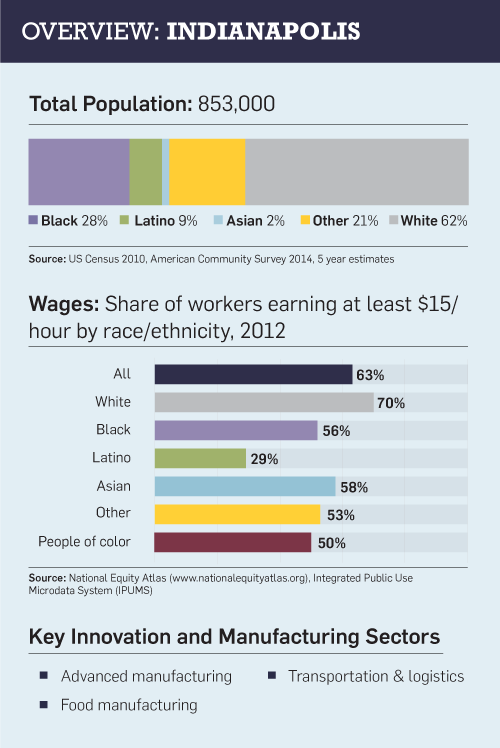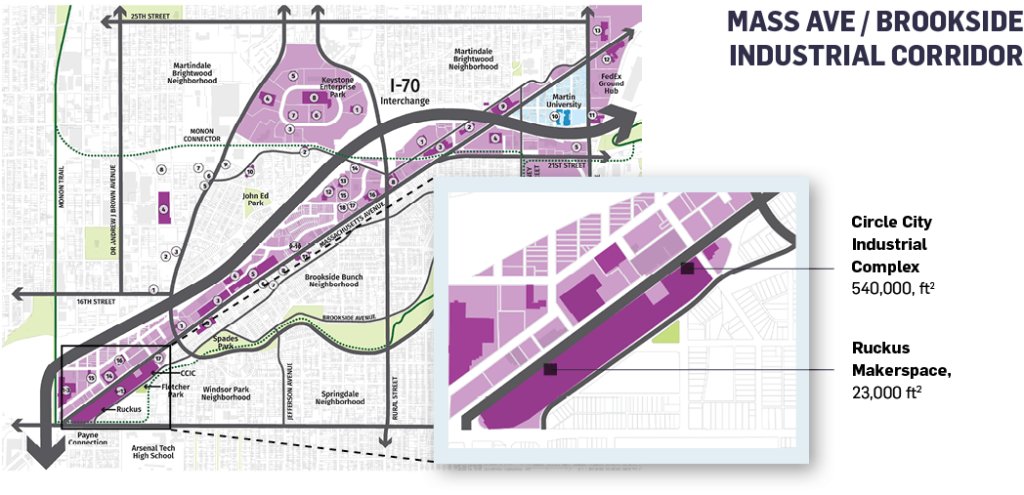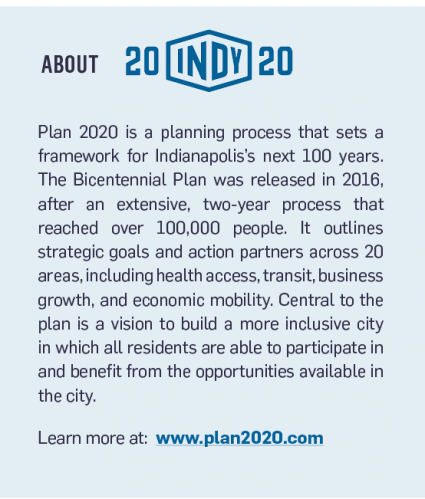Indianapolis City Snapshot
On the cusp of Indianapolis’s 200th anniversary in 2020, its government and community leaders are confronting equity issues head-on.
“A growing number of young people, particularly those of color, are growing into adulthood without access to jobs that offer any hope of earning a living wage,” wrote Bill Taft, director of LISC Indianapolis, in a 2015 opinion piece.1 “This kind of widespread lack of opportunity is costly to these citizens, their families and our city as a whole. Since Indianapolis has the fastest-growing minority population of any Midwestern city, this gap in opportunity must be addressed if we have any hope of offering a fulfilling life to these citizens and remaining a healthy city.”
This call to action is echoed in Plan 2020, a broad-based community process launched by the city in 2013 to create a healthier, more inclusive, more resilient, and more competitive city. Central to the plan is a vision to build a more inclusive city in which all residents are able to participate in and benefit from the opportunities available in the city.2
“Our EIE project as a whole was intended to increase equity in hiring in manufacturing.”
TOM ORR, LISC INDIANAPOLIS
The Equitable Innovation Economies (EIE) pilot presented an opportune moment for LISC Indianapolis and Plan2020 to work collaboratively to reach the dual goals of embedding equity objectives in an emerging citywide policy framework, as well as in LISC’s industrial revitalization activities. “Our EIE project as a whole was intended to increase equity in hiring in manufacturing,” said Tom Orr, Senior Program Officer at LISC Indianapolis, describing how LISC viewed the opportunity as a platform to pursue equity in the manufacturing sector. “We also wanted to look at the demographics of owners who are seeking to expand or start up manufacturing businesses in Indianapolis.” Through a two-year planning process in 2013-2014, City officials and LISC identified the Mass Ave/Brookside Industrial Corridor as a priority for revitalizing industrial activity and employment.

RecycleForce provides a wide array of comprehensive recycling services in Indiana and employment opportunities for formerly incarcerated individuals.

The Urban Land Institute’s Daniel Rose Fellowship also brought in a panel of external leaders to assess opportunities for the area, solidifying its importance for the city. The Corridor is a 480-acre industrial neighborhood located northeast of downtown Indianapolis. It encompasses several large industrial complexes, scattered small industrial buildings, and vacant land challenged by deteriorating structures, fragmented ownership, and environmental contamination.
Despite these disadvantages, the team identified assets that could be leveraged for revitalization: existing industrial infrastructure, proximity to interstate transportation, and visibility and accessibility to local workforce in adjacent neighborhoods with low-income and black communities. An economic cluster analysis discovered that the Corridor was particularly suitable for fast-growing firms in sectors that could stimulate good-quality jobs such as advanced manufacturing, transportation and logistics, and food manufacturing. Developers also recognized the area’s potential. Riley Area Development Corporation (RADC), a non-profit developer, partnered with Teagen Development on the Circle City Industrial Complex (CCIC), a gateway site to the rest of the Corridor. Their proposal included industrial and manufacturing uses focused on food, metalworking, and other customized products as well as a makerspace, entertainment venue and retail.
“We wanted to increase public access and engagement with the Corridor, to support existing manufacturers, and to grow small-scale manufacturing by lowering barriers to entry for craftsmen, inventors, and designers”, says Eric Strickland, Executive Director of RADC, which will own and manage Ruckus, the 23,000 square foot makerspace.

“We wanted to increase public access and engagement with the corridor, to support existing manufacturers, and to grow small-scale manufacturing.”
ERIC STRICKLAND, RILEY AREA DEVELOPMENT CORPORATION
Residents from neighboring communities expressed support for a balanced and inclusive approach to development. East Side neighborhoods such as Windsor Park have been physically disconnected from the rest of the City due to a major highway development and have experienced years of underinvestment. Jen Eamon, President of the Windsor Park Neighborhood Association, views CCIC as one of several developments that could bring much-needed revitalization and job opportunities for Windsor Park’s residents: “Our neighborhood is more diverse than the city as a whole, and this diversity has been identified as a community value. Our neighborhood supports the development of Ruckus Maker Space because it supports the development of new entrepreneurs by providing a shared work and idea space and the tools to take an idea and develop it into a marketable product. As development continues both at the CCIC and along the Mass Ave/Brookside Industrial Corridor, we hope to see neighbors working at new and expanded businesses.”
LISC designated the Mass Ave/Brookside Industrial Corridor as a FOCUS (Fostering Commercial Urban Strategies) district, directing significant financial resources, staff and technical support towards the CCIC redevelopment and reinvestment. On top of this designation, the area was officially recognized as a “Promise Zone,” by the Federal Government in 2015, helping LISC and RADC obtain federal and local funding for facade improvements and other renovation priorities.
Strategic discussions continued at the citywide level: Plan 2020 staff, the City’s Chamber of Commerce, and the EIE pilot group helped LISC to outline its equity priorities for this Corridor. These included connecting growing manufacturing businesses with available sites, and prioritizing local workforce development partnerships to directly improve access to quality jobs in the manufacturing sector for low-income residents and people of color in neighboring communities.

Rendering of the Circle City Industrial Complex Redevelopment
“Through our partnership, we have outlined a set of equity impacts we’d like to track with RADC, which provides demographics of new hires and business owners,” says Tom Orr. LISC worked with EIE to develop a set of potential indicators and metrics on job creation numbers, job quality in terms of wages and opportunities for advancement, and workforce demographics like race, ethnicity, and educational attainment.
RADC is focusing on supporting companies of all sizes and at all stages of the life cycle to ensure that start-ups, mid-stage companies and legacy manufacturers alike have the resources they need to stay and thrive in Indianapolis. However, they are encountering obstacles as they begin to roll out data collection and track business progress. “It’s been a challenge for us to understand the direct person impact on workers,” says Eric Strickland. “The largest company here employs just 75 people, so we’re going on smaller fishing trips, attracting smaller companies. Each of these small companies has specific tailored needs. Attracting several small firms is often much more work than attracting one big fish.”
As a next step, the organizations are seeking to connect Corridor firms with short-term and inexpensive hiring and training options. The goal is to take a “just in time” approach to job placement. LISC and RADC will pinpoint specific training needs of firms in the Corridor as they move in or expand – for example, a firm in the Corridor has a projected need for at least twenty trained and certified welders over the next year. They plan to engage workforce partners in the adjacent neighborhoods, such as Center for Working Families and Exodus Refugee Immigration, who can help recruit and train neighborhood workers to be job ready when openings such as these occur. With the help of EIE funding, LISC is also integrating these equity indicators into a software platform that will allow them to track this data across FOCUS sites throughout Indianapolis.
 Plan 2020 was formally issued in 2016, outlining specific strategies for advancing economic mobility, supporting business growth, and other priority action areas. For LISC, this serves as an important roadmap for building broader consensus: moving forward, LISC will pursue partnerships with the City, workforce development, and economic development entities to develop a stronger collective focus on creating opportunities in communities of color and concentrated poverty. The goal is to ensure that business attraction and expansion in core urban neighborhoods is tied to career employment pathways for residents through skill development and ongoing recruitment partnerships.
Plan 2020 was formally issued in 2016, outlining specific strategies for advancing economic mobility, supporting business growth, and other priority action areas. For LISC, this serves as an important roadmap for building broader consensus: moving forward, LISC will pursue partnerships with the City, workforce development, and economic development entities to develop a stronger collective focus on creating opportunities in communities of color and concentrated poverty. The goal is to ensure that business attraction and expansion in core urban neighborhoods is tied to career employment pathways for residents through skill development and ongoing recruitment partnerships.
